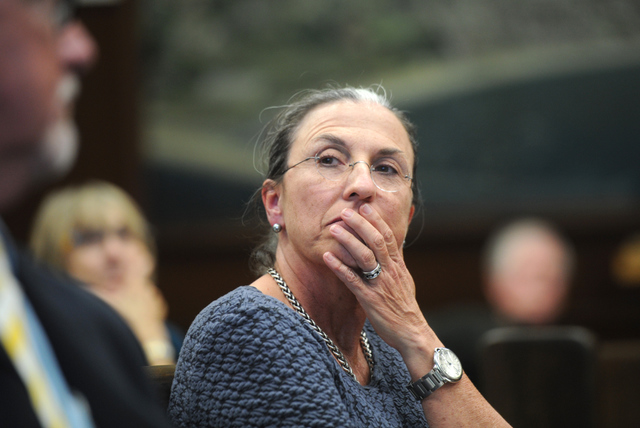
For years, it was the 11th Commandment among Santa Barbara developers that no one in their right mind would try building rental housing; they’d lose their shirts. But now, Bruce Corwin — one of the longtime owners of the Arlington Theater and Metropolitan Theaters chain — is threatening to do the impossible right downtown without the aid of any government subsidy.
By so doing, Corwin was challenged not just by a fellow developer but practically his next-door neighbor — Marge Cafarelli — who claimed Corwin’s proposed Arlington Village project violates City Hall rules and regulations regarding sound community planning and neighborhood compatibility. Ultimately, Cafarelli managed to get nowhere very slowly with the Santa Barbara City Council this Tuesday, which — after nearly four hours of deliberation — voted 6-to-1 to deny her appeal and let Corwin proceed with his plans to build a three-story, 33-unit apartment complex right next to the Arlington Theater.
That’s largely because both sides of Santa Barbara’s long-simmering debate over residential densities profess to support rental housing. But certainly it didn’t hurt the “Village” that the Corwins — although they live in Los Angeles — have been a major presence in Santa Barbara’s business and political life for more than 50 years. By contrast, Cafarelli — who is currently building a mixed-use project on the Victoria Street side of the Arlington dubbed Alma del Pueblo that offers million-dollar condos and indoor/outdoor market space — barely qualifies as a new-comer. Still, Cafarelli was roundly praised by all the councilmembers for identifying a serious weak spot in Corwin’s plans, one which Corwin’s agents had stubbornly insisted — until Cafarelli filed her appeal — simply could not be fixed.

Given that the Arlington Theater ranks among the Holy Trinity of Santa Barbara’s defining architectural gems — the other two being the courthouse and the mission — any effort to squeeze such different projects so cheek by jowl into its immediate orbit might have been destined to end in conflict. Initially, both the Corwins and Cafarelli were intent on pursuing complimentary condo projects. And they would share a driveway on Chapala Street. But as the bottom fell out of the condo market, the Corwins were persuaded to explore rental housing instead. Given that they’d owned the Arlington Theater since 1962, land costs would not be the prohibitive factor it is for so many developers.
Teaming up with architect Detty Peikert — a devotee of the “affordable by design” school of smart-growth thinking — the Corwins switched gears two years ago and submitted new plans. Not only would the Arlington Village offer rental units, but the development’s overall footprint would be smaller — the average unit size is 858 square feet — and priced to the less-than-luxury market of middle-income workers. But instead of putting all the parking underground — as the Corwins had planned when contemplating condos — Arlington Village would maintain a significant portion of street level parking.
Cafarelli, who spent nearly $4 million building underground parking for the Alma, was unhappy by this turnabout. She was especially troubled by the 55-foot trucks and buses — support transport for the bigger acts — that would continue to park in the Arlington lot competing with Alma residents for ingress and egress out of the shared Chapala Street driveway. City traffic engineers expressed similar concerns and pushed the Corwins to explore carving an additional exit onto Sola Street to prevent what looked like a foreseeable traffic nightmare from occurring. But consultants hired by the Corwins said it couldn’t be done.
Speaking to the City Council Tuesday, Cafarelli all but accused the Corwins of being cheap. If she could afford to build underground parking, then certainly the Corwins — who had owned the property for 51 years — had no excuses not to. She showed video snippets of Historic Landmarks Commission deliberations in which one commissioner — Bill LeVoie, well known for his salty judgments — complained that the Corwins proved unresponsive to suggestions because they were building rental housing. One critic sniped the Arlington Village was architecturally “ordinary.”
The big buses and trucks needed by the big acts currently descend upon the Arlington lot only about 12 times a year. What happens, Cafarelli demanded, if the Corwins were to sell to a new operator who booked more and bigger acts? And even Jack Johnson — famous as a relatively unadorned acoustic strummer — needed three big buses at his recent show, she noted. And in the snippets showed by Cafarelli, city traffic engineers described the truck management plans drawn up by the Corwins as “complicated.”
It was obvious, however, the minute Bruce Corwin opened his mouth that Cafarelli stood no chance. Where Cafarelli spoke staccato fast, Corwin was slow, measured, and confident. “We are very proud of our architecture,” he said. “The Arlington was going to be torn down until we stepped in and saved this glorious, glorious building. We love it. We love this city.” The Corwins, he said, could have cashed out by building condos, but Santa Barbara has a crying need for rental housing. “We made a decision to blaze a trail for others to follow,” he explained.
Joining Corwin was former mayor Hal Conklin, who said the eruption of State and Victoria streets as a cultural destination district — the new Ensemble Theater, the Granada, plans to remodel the art museum, a new downtown library entrance garden, Alma del Pueblo, and the Arlington Village — was the fruition of big dreams hatched by civic visionaries more than 20 years ago. Former Downtown Organization director Marshall Rose blessed the Arlington Village as did the head of the Santa Barbara Jewish Federation.
Shortly after Cafarelli appealed, the experts hired by the Corwins discovered that a Sola Street exit could work after all. Cafarelli suggested the Sola solution might not actually work because the driveway grade might cause the big rig vehicles to scrape bottom. Cafarelli had a handful of business owners expressing concern over the net loss of 86 surface parking spaces now rented out by downtown workers. City lots are nearly four times as expensive, they complained; where could they go?
That is a problem all the councilmembers agreed needed to be addressed. Why wasn’t the lot owned by the Parks and Recreation Department at the Louise Lowry Davis Center enlisted to create more parking opportunities, they all asked. The Granada Theater parking lot, it was pointed out, still has an abundance of empty stalls. Likewise, the councilmembers seemed resolved that the Historic Landmarks Commission and the Architectural Board of Review really weren’t the right venue for addressing the broader planning issues posed by such projects; the planning commission is.
Rental projects do not typically go to the planning commission, but if more rental developments are submitted in response to new city inducements or shifting market realities, that will change. At the end, Cafarelli was not given any consolation prize for her efforts, but she did receive lots of consolation. After councilmember Frank Hotchkiss heaped thanks on Cafarelli for improving the Corwins’ project, he concluded, “I don’t know if you can take any solace from that, but I offer it anyway.”



